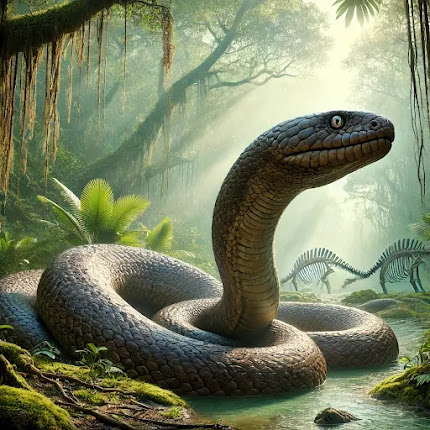Vasuki Indicus – The Ancient Serpent of Gujarat and Its Link to Lord Shiva
Vasuki Indicus – The Ancient Serpent of Gujarat and Its Link to Lord Shiva
Introduction
A remarkable discovery has surfaced in India, one that bridges the realms of science and mythology. In April 2024, paleontologists uncovered fossilized remains of a colossal prehistoric snake, Vasuki indicus, in the Panandhro Lignite Mine of Gujarat. This snake, estimated to be between 36 to 50 feet (11 to 15 meters) long, is one of the largest serpents ever recorded, dating back 47 million years to the Middle Eocene epoch.
The name Vasuki indicus immediately draws attention, as it resonates with Vasuki, the legendary serpent king of Hindu scriptures. Vasuki is revered in the Vedas, Puranas, and the Mahabharata, known for his role in the Samudra Manthan (Churning of the Ocean) and his presence around Lord Shiva’s neck. This article explores both the scientificand spiritual significance of Vasuki indicus, examining whether the ancient myths of giant serpents hold any truth in the light of modern discoveries.
1. The Discovery of Vasuki Indicus: Facts & Evidence
Where and When Was It Found?
The fossils of Vasuki indicus were discovered in the Panandhro Lignite Mine, Kutch Basin, Gujarat, India in April 2024. This region has been known for its rich prehistoric fossils, but finding a snake of this size is a rare and groundbreaking discovery.
How Big Was Vasuki Indicus?
Based on the fossilized vertebrae, scientists estimate that Vasuki indicus measured between 36 to 50 feet (11 to 15 meters), making it one of the largest snakes to have ever lived.
Age of the Fossil
Dating methods suggest that this species existed 47 million years ago, during the Middle Eocene epoch, a time when India's climate was much warmer and more tropical.
Comparison with Other Prehistoric Snakes
| Name | Length | Period | Location |
|---|---|---|---|
| Vasuki indicus | 36–50 ft | 47 million years ago | India |
| Titanoboa cerrejonensis | 42 ft | 58 million years ago | South America |
| Gigantophis garstini | 35 ft | 40 million years ago | Africa |
How Was It Identified?
Scientists found 27 well-preserved vertebrae, initially believed to be from a crocodile. However, detailed study confirmed that they belonged to an ancient snake.
What Did Vasuki Indicus Eat?
Based on the fossil evidence, this giant snake likely ambushed its prey, which included:
- Large fish
- Turtles
- Early whale species
Climate & Environment of Vasuki Indicus
At that time, India was closer to the equator, experiencing a tropical rainforest climate with an average temperature of 28°C (82°F). Warm temperatures allowed reptiles like Vasuki indicus to grow to enormous sizes.
2. Vasuki in Hindu Mythology
Who Is Vasuki?
In Hindu scriptures, Vasuki is the king of serpents (Nāgarāja), often depicted with multiple heads and a divine glow.
- He coiled around Lord Shiva’s neck, symbolizing power, time, and eternity.
- He played a crucial role in the Samudra Manthan (Churning of the Ocean), where he acted as the rope used by devas (gods) and asuras (demons) to churn the ocean for Amrita (nectar of immortality).
Vasuki’s Mention in Hindu Scriptures
- Rig Veda: Mentions the Nāgas (serpent deities) and describes their divine powers.
- Mahabharata: Details Vasuki’s interaction with the Pandavas and his role in various celestial events.
- Bhagavata Purana: Describes Vasuki as a guardian of the underworld.
- Shiva Purana: Explains why Lord Shiva wears Vasuki around his neck, signifying control over time and death.
Connection to the Discovery of Vasuki Indicus
- The size of Vasuki indicus aligns with descriptions of Vasuki in the Mahabharata and Puranas.
- Ancient sages might have encountered giant serpents, leading to the creation of Vasuki’s mythology.
3. Why Is Shiva Associated with Snakes?
Lord Shiva’s association with snakes represents fearlessness, eternity, and cosmic energy. Vasuki’s presence around Shiva’s neck signifies control over time and death.
Scientific Explanation of Snake Worship in Hinduism
- Ancient India had a high population of snakes, leading to their mythological significance.
- Many prehistoric snakes were gigantic, inspiring divine stories.
Nag Panchami: Worship of Snakes in India
Hindus still worship snakes on Nag Panchami, believing they bring protection, fertility, and spiritual power.
4. Scientific & Mythological Parallels: Could Vasuki Have Been Real?
| Mythology | Science |
|---|---|
| Vasuki was a gigantic serpent | Vasuki indicus was a 50-foot-long snake |
| Lived in ancient India | Found in Gujarat, India |
| Assisted in Samudra Manthan | Lived in a warm, tropical oceanic environment |
Ancient texts could be referring to real creatures that once existed, later turned into divine legends.
5. Myth and Science Coexisting
The discovery of Vasuki indicus does not prove that the mythical Vasuki was real, but it does suggest that ancient Indians were aware of gigantic serpents. Myths are often based on real events, passed down through generations in poetic or symbolic forms.
- Vasuki indicus is one of the largest prehistoric snakes, found in Gujarat, India.
- Vasuki, the mythological king of serpents, is deeply revered in Hinduism.
- Ancient India’s warm climate allowed gigantic snakes to exist, possibly inspiring Vasuki’s legend.
- The connection between science and spirituality is stronger than we think.
This discovery serves as a reminder that our ancient texts may hold more truth than we realize, waiting to be unraveled through modern science.
The universe is whispering its secrets—are you ready to listen?
Dare to know more? Enter the realm of cosmic truth.
At the end of this journey, you will never see reality the same way again. Are you ready to break the illusion? Deep dive into www.rudradoota.com








0 Comments:
Post a Comment
Subscribe to Post Comments [Atom]
<< Home